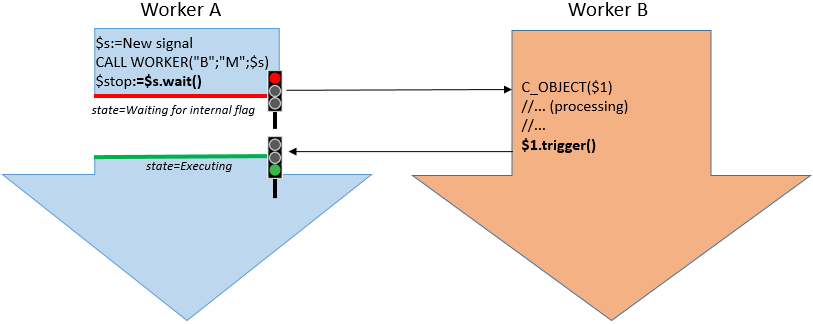Signal
Les signaux sont des outils fournis par le langage 4D pour gérer les interactions et éviter les conflits entre les process dans une application multiprocessus. Les signaux vous permettent de vous assurer qu'un ou plusieurs process attendront la fin d'une tâche spécifique avant de poursuivre leur exécution. Tout process peut attendre et/ou libérer un signal.
Les sémaphores peuvent également être utilisés pour gérer les interactions. Les sémaphores permettent de s'assurer que deux ou plusieurs process ne modifient pas la même ressource (fichier, enregistrement...) en même temps. Seul le process qui a posé le sémaphore peut le retirer.
Objet signal
Un signal est un objet partagé qui doit être passé comme paramètre aux commandes qui appellent ou créent des workers ou des process.
Un objet 4D.Signal contient les méthodes et propriétés intégrées suivantes :
Tout worker/process appelant la méthode .wait() suspend son exécution jusqu'à ce que la propriété .signaled soit mise à true. Lorsque vous êtes en attente d'un signal, le process appelant n'utilise pas de CPU. Cela peut être très intéressant pour les performances des applications multiprocess. La propriété .signaled devient est mise à True lorsqu'un worker/processus appelle la méthode .trigger().
A noter que pour éviter les situations de blocage, la méthode .wait() peut également revenir après qu'un délai d'attente défini ait été atteint.
Les objets Signal sont créés avec la commande New signal.
Travailler avec des signaux
Dans 4D, vous créez un nouvel objet signal en appelant la commande New signal. Une fois créé, ce signal doit être passé en paramètre aux commandes New process ou CALL WORKER afin qu'elles puissent le modifier lorsqu'elles ont terminé la tâche que vous souhaitez attendre.
signal.wait()doit être appelé par le worker/process qui a besoin qu'un autre worker/process termine une tâche pour pouvoir continuer.signal.trigger()doit être appelé par le worker/process qui a terminé son exécution afin de libérer tous les autres.

Une fois qu'un signal a été libéré par un appel à signal.trigger(), il ne peut plus être réutilisé. Si vous souhaitez définir un autre signal, vous devez à nouveau appeler la commande New signal.
Etant donné qu'un objet signal est un objet partagé, vous pouvez l'utiliser pour retourner les résultats des workers/process appelés, à condition de ne pas oublier d'écrire les valeurs dans une structure Use...End use (voir exemple
Exemple
var $signal : 4D.Signal
// Création d'un signal
$signal:=New signal
// appel du process principal et exécution de la méthode OpenForm
CALL WORKER(1;"OpenForm";$signal)
// autre calcul
...
// En attente de la fin du process
$signaled:=$signal.wait()
// Traitement des résultats
$calc:=$signal.result+...
Méthode OpenForm :
#DECLARE ($signal : 4D.Signal)
var $form : Object
$form:=New object("value";0)
// Ouvrir le form
$win:=Open form window("Information";Movable form dialog box)
DIALOG("Information";$form)
CLOSE WINDOW($win)
// Ajout d'un nouvel attribut à votre objet partagé $signal pour passer votre résultat à l'autre process :
Use($signal)
$signal.result:=$form.value
End use
// Envoyer le signal au process en attente
$signal.trigger()
Sommaire
| .description : Text contient une description personnalisée pour l'objet Signal |
| .signaled : Boolean contient le statut courant de l'objet Signal |
| .trigger( ) met la propriété signaled de l'objet signal à true |
| .wait( { timeout : Real } ) : Boolean place le process courant en attente jusqu'à ce que la propriété .signaled de l'objet signal devienne true ou que le timeout optionnel expire |
.description
Historique
| Release | Modifications |
|---|---|
| 17 R4 | Ajout |
.description : Text
Description
La propriété .description contient une description personnalisée pour l'objet Signal.
.description peut être définie à la création de l'objet signal ou à tout moment. Notez que comme l'objet Signal est un objet partagé, tout accès en mode écriture à la propriété .description doit être encadré par les mots-clés Use...End use.
Cette propriété est en lecture-écriture.
.signaled
Historique
| Release | Modifications |
|---|---|
| 17 R4 | Ajout |
.signaled : Boolean
Description
La propriété .signaled contient le statut courant de l'objet Signal. Lorsque le signal est créé, .signaled est False. Elle devient True lorsque la fonction .trigger( ) est appelée sur l'objet.
Cette propriété est en lecture seule.
.trigger()
Historique
| Release | Modifications |
|---|---|
| 17 R4 | Ajout |
.trigger( )
| Paramètres | Type | Description | |
|---|---|---|---|
| Ne requiert aucun paramètre |
Description
La fonction .trigger() met la propriété signaled de l'objet signal à true et réveille tous les workers ou process attendant ce signal.
Si le signal est déjà dans l'état signaled (i.e., la propriété signaled est déjà true), la fonction ne fait rien.
.wait()
Historique
| Release | Modifications |
|---|---|
| 17 R4 | Ajout |
.wait( { timeout : Real } ) : Boolean
| Paramètres | Type | Description | |
|---|---|---|---|
| timeout | Real | -> | Délai d'attente maximum en secondes pour la réponse |
| Résultat | Boolean | <- | Etat de la propriété .signaled |
Description
La fonction .wait() place le process courant en attente jusqu'à ce que la propriété .signaled de l'objet signal devienne true ou que le timeout optionnel expire.
Pour prévenir tout code bloquant, vous pouvez passez un temps d'attente maximum en secondes dans le paramètre timeout (les décimales sont acceptées). Les décimales sont acceptées.
Si le signal est déjà dans l'état signalé (c'est-à-dire que la propriété .signaled est déjà true), la fonction retourne immédiatement, sans attendre.
La fonction retourne la valeur de la propriété .signaled.
- Evaluer cette valeur permet de savoir si la fonction a retourné à cause de l'appel de
.trigger( )(.signaledest true) ou si le timeout a expiré (.signaledest false). - false si le délai a expiré avant que le signal ne soit déclenché.
Attention : L'appel de .wait( ) sans timeout dans le process principal de 4D n'est pas recommandé car il pourrait geler l'ensemble de l'application 4D.
L'état d'un process qui attend un signal est
En attente d'un marqueur interne.